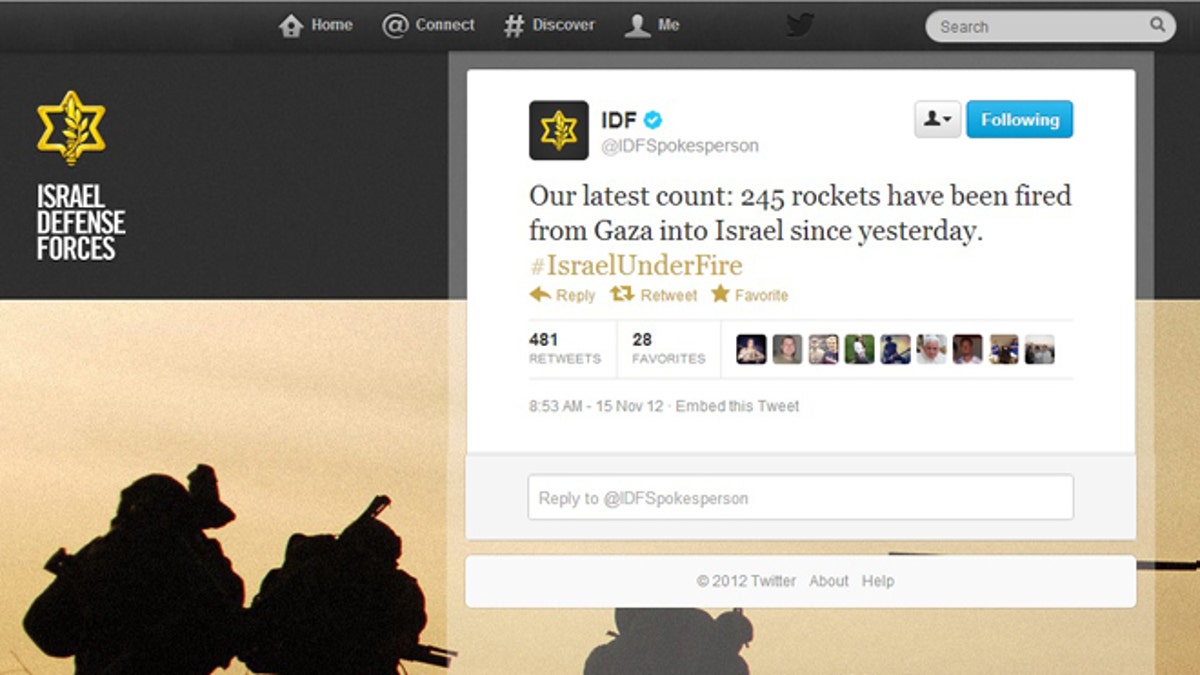
Nov. 15, 2012: As rockets fly in a new outbreak of deadly violence between Gaza militants and Israel, the latest battlefront is Twitter and social media. (Twitter)
A new voice has been added to the cacophony of war. Amid the chatter of guns, the blast of grenades and the screech of jets, there are tweets. Social media is a new battlefront in the escalating tensions between Israel and Hamas.
It's a facet of 21st century warfare that will increasingly become the norm in conflict, an expert says.
Pictures: Devastation as Israeli air strike kills Hamas leader
As they fire rockets across the physical battleground the Israeli Defense Force and The Al-Qassam Brigade, the military wing of Hamas, are simultaneously firing off bloody threats on Twitter, posting footage of attacks on YouTube and propaganda pictures on photo sharing site Flickr.
The IDF heralded the start of last night's campaign, named "Operation Pillar of Defense" with a simple tweet:
Minutes later the IDF tweeted it had assassinated Ahmed Al-Jabari, head of the military wing of Hamas, following it up with a link to a YouTube video of the attack and a photograph of Jabari stamped with the word "ELIMINATED."
[sidebar]
"We recommend that no Hamas operatives, whether low level or senior leaders, show their faces above ground in the days ahead," the IDF warned, prompting a return tweet from The Al-Qassam Brigade that they had "opened the gates of hell."
As the shells continue to rain down on both sides, with women and children reportedly among the casualties, the Twitter war unfolds with both groups tweeting real-time updates about the military action they are taking.
The military groups have even created their own hashtags to document the violence -- the IDF tweeting with #PillarOfDefense and Hamas using #GazaUnderAttack.
Associate professor of communications and journalism at the Queensland University of Technology Axel Bruns said the inclusion of social media in modern warfare tactics, both by military organizations and civilians, is becoming the norm.
"I think we'll see more and more of it and probably not just necessarily between the combatants themselves but from people in the areas, the bystanders caught up in the process," he said.
Timeline of Israel and Hamas conflict in Gaza since 2002
"Obviously people on the ground will have Internet access, smartphones and other devices to take footage and photos and share them, and I think many will get involved quite deliberately to push their message."
Bruns said the Israel-Palestine conflict, more than any other, was ideal for playing out on social media.
[pullquote]
"On both sides there's significant knowledge of English, so this is something that can really be played out in front of the world's media and on the world stage," he said.
"This is an issue that is very visible, an issue where there are significant supporters for both sides all over the world, and it can be explained to a world audience in a language they'll understand so it's probably quite likely to be taken up by lots of people via social media.
"There is also significant access to technology and Internet on both sides, it's perhaps slightly more sophisticated on the Israeli side than the Palestinian side, but it's more equal than it would be between say the U.S. army or a very developed army versus an enemy which is much more rurally based."
Recent tweets from the two groups suggest there will be no relief for either Israel or Palestine in the immediate future.
Hamas: "Criminal enemy who started the battle treacherously should wait Black Days and Coming Hits" #GazaUnderAttack #Gaza #Hamas"
The IDF responded: "Tonight, more than 1 million Israelis are going to sleep in bomb shelters. This operation will bring a better tomorrow."
Read more tech and science news at news.com.au.
